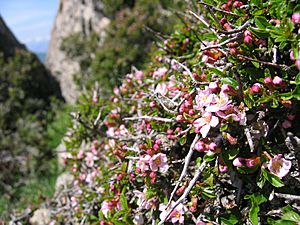Mountain cherry facts for kids
Quick facts for kids Mountain cherry |
|
|---|---|
 |
|
| Conservation status | |
| Scientific classification | |
| Synonyms | |
|
Prunus prostrata is a tough shrub often called the mountain cherry or rock cherry. It grows naturally in high, rocky places, usually above 2,000 meters (about 6,500 feet) and sometimes as high as 4,000 meters (over 13,000 feet)! You can find it in countries like Israel, Turkey, Greece, and parts of North Africa. This plant is known for hugging the ground, which helps it survive in windy, cold mountain environments.
The mountain cherry usually grows about 0.15 to 0.30 meters (6 to 12 inches) tall. Sometimes it can reach up to 1 meter (about 3 feet). It often grows in cracks on vertical rock surfaces. Its branches tend to follow the shape of the ground or rock. When climbers see patches of this plant flowering on rocky slopes, sometimes still covered in snow, it's a beautiful sight.
What Does it Look Like?
The bark of the mountain cherry is a reddish-brown color. Its leaves are oval-shaped with jagged edges, like a saw. The underside of the leaves has soft, white, fuzzy hairs. The top side of the leaves is smooth. The leaf stems do not have special glands.
The flowers are a unique light rose color. They bloom in April or May. They grow alone or in pairs and are almost directly attached to the stem. Each flower has a tube-shaped outer leaf part called a calyx. There are about 22 to 24 stamens (the parts that make pollen). The fruit is red and oval-shaped. It has thin flesh and ripens in July.
What is it Used For?
The fruit of the mountain cherry can be eaten, but people usually don't prefer it. The main use for this plant is in ornamental gardening. This means people grow it because it looks pretty. It can also be grafted onto another plant to grow into a small tree.
How it Got its Name
The name Prunus prostrata was given by Jacques Labillardière. He was a French botanist, a scientist who studies plants. He named it after returning from a trip to the Middle East where he collected plants.
The word "prostrata" means "lying on the ground." This name fits the plant perfectly because it tends to grow very close to the ground. This low-growing habit is important for its survival in high, windy mountains. A branch that is "prostrate" bends back down to the ground.
Ancient Plant History
Scientists have studied tiny plant parts, like pollen, from a core sample taken in a valley in southern Spain. They found evidence of P. prostrata from long ago. This plant type was present about 2,630 years ago until about 1,550 years ago. It appeared again from about 790 years ago until today.
During these times, the mountain cherry grew in "high-altitude open pine forests." This means it lived in forests with pine trees that were high up in the mountains and not too dense. The core sample goes back over 8,000 years, but there is no sign of Prunus prostrata in it before 2,630 years ago.


